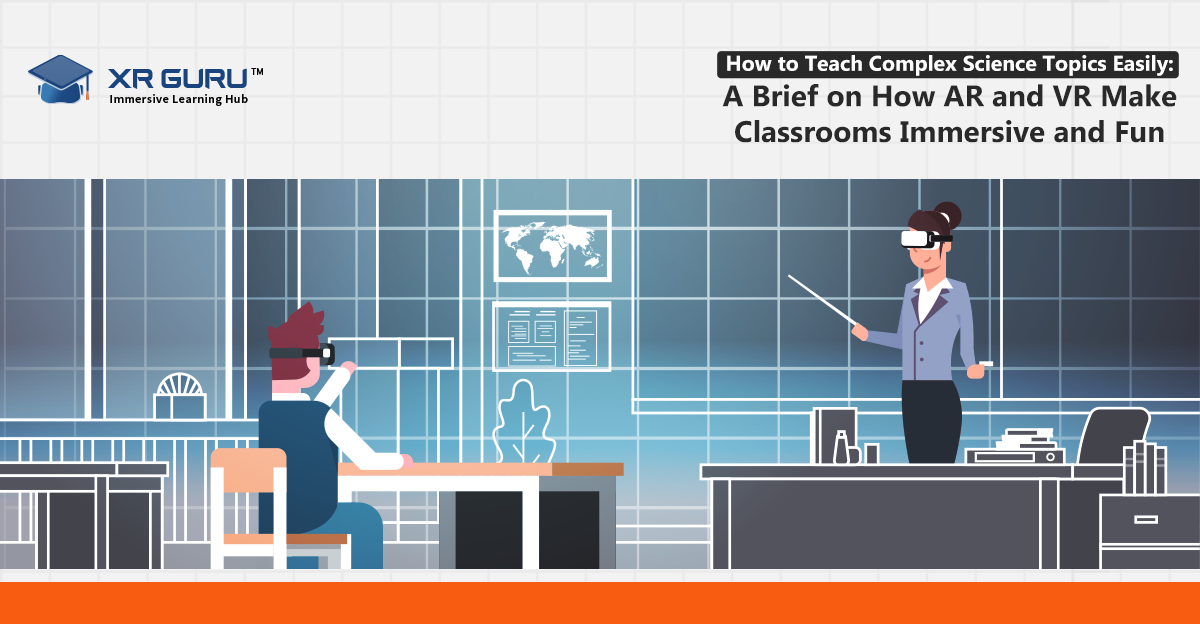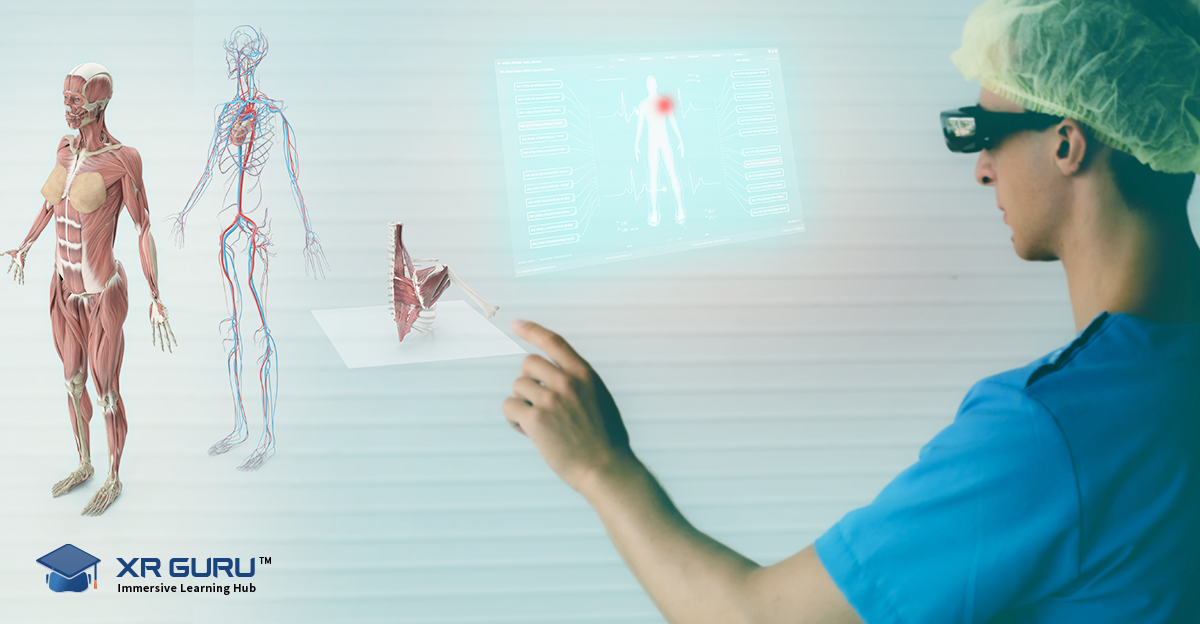How to Teach Complex Science Topics Easily: A Brief on How AR and VR Make Classrooms Immersive and Fun

As several schools begin to adopt AR/VR, this is the time to ponder the question,
'How can immersive technologies enhance the teaching process?'
So, have you taken a long, hard look at your teaching process?
Are you finding it difficult to teach complex science topics using traditional teaching methods?
Adopting immersive technologies like Augmented and Virtual Reality in your teaching process can help you teach complex science topics with relative ease.
On November 16, XR Guru is conducting a webinar on "How to Teach Complex Science Topics Easily." The webinar will discuss how K-12 teachers can use Augmented & Virtual Reality platforms to teach science.
Here is a recap of our blog:
- What is Augmented & Virtual Reality?
- What is Augmented Reality?
- What is Virtual Reality?
- What Role Will AR and VR Play in Education
- What Benefits AR/VR Provide to K-12 Educators and Students
- How Can K-12 Educators Use Augmented & Virtual Reality?
- AR/VR Based Demonstrations
- Learning Anatomy Has Never Been Easier
- Visualized, Immersive Learning
- Supplemental Advanced Placement (AP) Classes for Middle School
- Ready to Jump on the AR/VR Bandwagon?
What Is Augmented & Virtual Reality Technologies?
Before we delve further, it is important to understand a few things about augmented and virtual reality.
What Is Augmented Reality?
You can think of augmented reality technology as a magic trick capable of giving life to computer-generated graphics in the real-world environment.
If you move your mobile camera to a space, AR enables you to see graphical elements in real-time on your mobile screen. AR does not replace the existing environment; it blends the physical and the real-world atmosphere.
What Is Virtual Reality?
Virtual reality is a computer-generated, interactive 3D simulation with authentic elements and surroundings that alter the user's perception of reality and make them feel captivated in the life-like environment. In other words, VR is a technology that tricks your mind into believing you are somewhere you are physically not present.
What Role Will AR and VR Play in Education
I can hear you asking,
'Hold on, how can these technologies help in the teaching process?'
Well, here is a brief answer:
Augmented & virtual reality offers an interactive, engaging learning experience and helps teachers add visual examples, 3D simulations, and gaming elements to strengthen the existing syllabus. This, in turn, helps the students to learn faster and develop a deeper connection with the subject matter.
So, why AR/VR?
Isn't our education system a bit boring? Shouldn't we add something to spice up the educational experience?
Incorporating immersive technologies in education helps students touch, feel, and experience a subject instead of reading a theory. Furthermore, institutions can cut costs as AR/VR has the potential to replace textbooks, manuals, and other printed resources.
With
reports
predicting the value of augmented and virtual reality in the education sector to reach $19.6 billion by 2023, growing at a compound annual growth rate (CAGR) of 16.2%, it is evident a vast number of institutions are gearing up to improve the learning experience with augmented and virtual reality.

(Source:
MarketsandMarkets
)
What Benefits AR/VR Provide to K-12 Educators and Students
AR/VR technologies enable learners to feel, see, and experience subjects better.
AR/VR + education
= a winning formula.
Here are some benefits of using augmented and virtual reality technologies in schools:
- Immersive learning experience
- A visual approach to learning
- Hands-on experience without the risk factor and real-life consequences
- Heightened student engagement
- Better retention rates
- Enhanced remote learning
- Cost-effective
Excited about the benefits of AR/VR-powered education? Want to know more?
Join our webinar session
for more insights on effectively using augmented and virtual reality in the teaching process.
How Can Educators Use Augmented & Virtual Reality?
Here is how adopting AR/VR can enrich the way you teach science.
AR/VR-Based Demonstrations
Because of COVID-19, more K-12 educators are migrating towards online education, and it is becoming increasingly difficult to conduct laboratory sessions in a remote learning environment.
So, you may ask,
is it impossible to deliver practical training in online education?
It is possible with AR/VR. Using VR, you can set up virtual labs and assist students in performing chemistry and physics experiments from the comfort of their homes. Further, with AR/VR projections, students can practice dissection biology experiments through their mobile phones.
Learning Anatomy Has Never Been Easier

Why use textbooks and 2D scientific diagrams to teach anatomy when you can use interactive 3D models and AR/VR projections that are proven to improve student interaction and level of understanding. Therefore, why not incorporate
AR/VR into your teaching method?
With AR/VR projections, K-12 students can view 3D models of the human anatomy and 'take apart' the body parts for a more thorough examination and greater comprehension.
Visualized, Immersive Learning
Would you rather read through a 50-page chapter to explain how a thermal powerplant works or show a 360° VR video to explain it in a few minutes?
The second option sounds like a smart thing to do, right?
Think about it: Wouldn't science topics be better structured as an image, a video, or a simulation rather than just text?
Our brains can process images much faster than text, so visualized learning can help students learn faster and retain information for a prolonged period. Studies show increased retention rates for students who learn through immersive learning methods.

(Stats source)
Using VR, science teachers can create role-plays, simulations, and immersive scenarios that can intrigue students' curiosity and encourage them to actively participate in classroom activities to boost their test scores and knowledge.
Supplemental Advanced Placement (AP) Classes for Middle School with XR Guru
You can do all the previously mentioned things and more with our immersive learning hub, XR Guru. Additionally, we offer supplemental content for middle school, high school, college, and Advanced Placement (AP) levels.
Advanced Placement is a program developed by the
College Board that presents students with an opportunity to learn university-level classes and earn college credit while in high school. Taking AP classes has several advantages and can help a student during the college admission process.
But what does this mean to a student in middle school?
The middle school courses build the foundation for AP courses in high school.
Is it beneficial to take advanced classes in middle school?
To answer your question in two words: Yes, absolutely.
With AR/VR-powered advanced classes for middle school, students can learn new skills and practice their newfound skills with advanced exercises in a simulated environment. Managed effectively, the middle school years can be a good opportunity to equip students with the knowledge and skills required to engage in a higher level of education such as scientific research and discovery.
Ready to Jump on the AR/VR Bandwagon?
Adopting AR & VR technology has a plethora of advantages. As AR/VR technology evolves with advancements in software development and in hardware, including higher quality and lower-cost headsets, more-and-more people and organizations are realizing its potential, and its application and use will undoubtedly increase. So, what are you waiting for? There has never been a better time to hop on the AR/VR train.
If you are convinced to incorporate AR/VR in your education process? XR Guru is an immersive learning platform that is a one-stop solution for all your AR/VR learning requirements. With an ever-growing content library and tools to create unique course content, XR Guru is your best option to deliver an immersive learning experience. Contact us for a free consultation on your AR and VR educational needs.
Join Us for Our Next Webinar
Title: How to Teach Complex Science Topics Easily.
Teaching complex science subjects with conventional tools such as textbooks can be a daunting task.
Are you eager to transform YOUR science teaching methods? Studies show using AR and VR can increase the engagement levels of students and help them learn faster. Join our forthcoming webinar on November 16, 2021, for insights on building interactive classrooms with AR and VR.
Host: Doug Smith
Time: 1:00 p.m. (EST)
Goal: To help educators understand the potential of adopting AR/VR tech in education and illustrate its usefulness when teaching science concepts.
Who can join this webinar? Educators, teachers, principals, and those planning to implement immersive technologies in their educational content.
Highlights:
Join this webinar if you want to:
- Know more about AR & VR
- Learn the potential of using AR & VR in education
- Discover exciting ways to engage your students in learning science
- Have guidance on getting started with AR/VR in your school.
Outcome: Attending this webinar can help you understand how adopting AR/VR tech can enrich the teaching experience.



Comments
Post a Comment